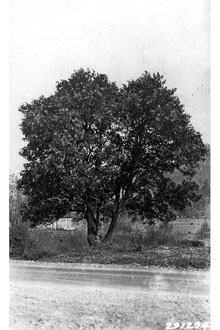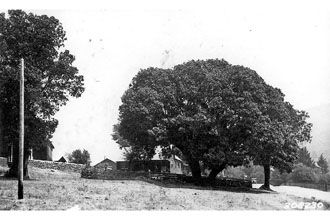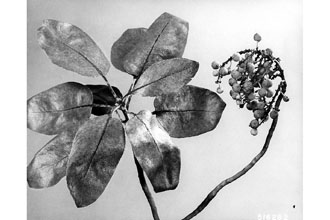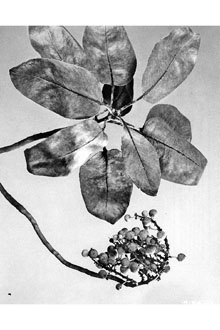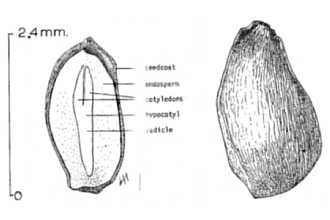Pacific Madrone
Scientific Name: Arbutus menziesii Pursh
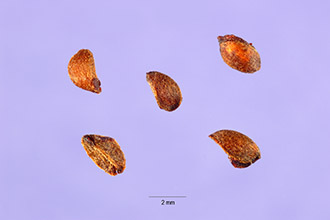
| General Information | |
|---|---|
| Usda Symbol | ARME |
| Group | Dicot |
| Life Cycle | Perennial |
| Growth Habits | Tree |
| Native Locations | ARME |
Plant Guide
Alternate Names
Madrone madroño, madroña, bearberry, strawberry tree
Uses
Ethnobotanic: In his diary of the Portolá expedition of 1769, Pedro Fages (1937:59) lists madrone as one of the foods of the Salinan. The Salinan, Miwok, Pomo, and other California tribes have long used the berries of Pacific madrone for food and to make cider. Berries within reach were hand picked and placed into baskets. The higher branches were shaken or hit with a long stick to knock off the berries into a basket held below or onto a cleared area of ground beneath the tree. The gathered berries were eaten fresh, made into cider, or cooked and dried for later use. Fresh berries were eaten in small quantities (Bocek 1984) probably because the high tannin content makes them astringent. The Miwok chewed the fresh or dried berries for flavor but did not swallow them (Barrett & Gifford 1933; Moerman 1998). Most often, the berries were used to make unfermented cider. The berries were first pounded into a course meal. The meal was placed into a straining basket, which was placed over another basket that was so tightly woven it could hold water. Water was poured into another watertight basket in which rocks, heated in the coals of a fire, were added. The rocks were constantly stirred to keep the basket from burning. The heated water was then poured over the meal until the entire flavor was extracted from the berries. Berries were strung to make necklaces, and leaves and berries were used as decorations (Moerman 1998). The berries were also used as bait to catch steelhead. © William R. Hewlett California Academy of Sciences @ Calflora The Miwok and the Cahuilla chewed the leaves to treat cramps and stomachaches (Barrett & Gifford 1933; Bean & Saubel 1972). Many tribes used an infusion of madrone bark to treat sores on the skin. The Pomo made a tannic tea from the bark that was used to wash sores, but not poison oak (Goodrich et al. 1980). However, it is probable that the Salinan taught the Padres at Mission San Antonio de Padua how to use the berries and leaves of Pacific madrone and the related manzanita to make a wash used for treating poison oak (Heinsen 1972). Bark tea was drunk to treat colds and sore throats. Pomo women used an infusion of the bark as an astringent beauty wash to close the pores and soften the skin on their faces. Wildlife: Pacific madrone trees provide edible berries and habitat for many bird species including robins, cedar waxwings and bandtailed pigeons, varied thrush, and quail. The trees provide perches and nesting places for many bird species. Cavity nesting birds that utilize Pacific madrone are red-breasted sapsuckers, woodpeckers, downy woodpeckers, mountain chickadees, house wrens, and western bluebirds (McMurray 1989). Mule deer, raccoons, ringtails, and bears eat the berries. Mule deer do not generally browse on mature leaves except during times of scarcity of other foliage. However, after fire the plants will sprout up with new shoots that are eaten by mule deer as well as domestic sheep, goats, and cattle. The flowers attract bees. Erosion control: Pacific madrone can prevent erosion in sites that experience frequent disturbance. The plants have a widely spreading root system and they quickly reestablish after disturbance by re-sprouting from the stump or underground burl (McMurray 1989). Other: The dense, fine-grained, wood is heavy and brittle. It has been used for flooring and cabinets but is generally unsuitable for use in construction because it does not dry uniformly and can crack and split. Pacific madrone does make a beautiful veneer and is used for pulp and firewood. Charcoal made from madrone wood has been used in the past as a component in gunpowder (Parsons 1966). The bark was sometimes used for tanning leather.
Status
Please consult the PLANTS Web site and your State Department of Natural Resources for this plant’s current status (e.g. threatened or endangered species, state noxious status, and wetland indicator values).
Description
General: Heath family (Ericaceae). Pacific madrone is an evergreen tree that is native to the northwestern Coast Ranges of North America. The trees have single or multiple trunks with rounded, spreading crowns. Mature trees reach heights of 6m to 30m or more depending on environmental conditions. The alternately arranged leaves are oval, (7 to 15 cm long), thick, and have finely serrated margins. The leaf surfaces are glossy dark green above with lighter grayish green beneath. Leaves remain on the plant for two years before they are shed. The striking cinnamon red bark is thin and smooth. The bark on young branches peels in large papery flakes to reveal an attractive, satiny green surface beneath that darkens with time to deep red. In midsummer, the exfoliated bark, along with shed leaves in shades of red to orange, form a lovely colorful carpet beneath the tree canopy (Saunders 1923). Fragrant bell-shaped flowers appear in large, showy clusters at the ends of the branches during the spring, from March through May, but sometimes as early as January. The flowers (8mm) are yellowish-white to pink and consist of 5 fused petals. The fruits are loose clusters of bumpy, scarlet red berries (8 to 12mm) that contain a mealy pulp and about 20 hard seeds. The genus was named from the Celtic word “arboise,” which means rough fruit (Young & Young 1992). The early Spanish Californians named the tree “madroño” after the strawberry tree (Arbutus unido), which grows in Spain and other nearby Mediterranean countries (Parsons 1966). The edible fruits ripen from the early fall until December or January. Distribution: Pacific madrone is native to the West Coast of North America and occurs from the Southern Coast Ranges of California to British Columbia in the north from 100 to 1500 m. Occasional populations are found in the Sierra Nevada Range at middle elevations. For current distribution, please consult the Plant Profile page for this species on the PLANTS Web site. Habitat: Pacific madrone is found on wooded slopes and canyons in oak, redwood, and mixed evergreen forests as well as in chaparral communities. The trees are commonly associated with other species and rarely occur in pure stands.
Adaptation
These trees are adapted to humid coastal sites as well as dry foothill slopes and canyons in areas with dry summers and mild winters. They grow on soils with low nitrogen and low moisture content.
Establishment
The Pacific madrone is a spectacular tree. Its showy bark, flowers and berries along with the gracefully crooked branches inspired Bret Harte to compose a poem about its loveliness (see Parsons 1966). But, alas, they can be difficult to grow. These trees should only be planted in very well drained soils in areas with non-alkaline water. Although generally started from seed, Pacific madrone may also be propagated from cuttings, grafting, or layers. To start from seed, gather the fruits from the trees when they are ripe—generally from October to December. Soften the berries by soaking them in water and then separate the seeds from the pulp. Completely dry the seeds before storing. Dried seeds may be stored for up to 2 years at room temperature. For best germination, use seeds that have been stratified by pre-chilling for one to two months at 2 to 5 degrees C. Plant the seeds, in either spring or fall, in containers that have been filled with a mix of peat, sand, and gravel. Allow the seedlings to reach at least two feet in height before transplanting. Established trees can live up to 200 years or more and do not transplant well, so select a site where the tree can remain permanently. Choose a place with full sun to partial shade well away from lawns and other plants that require summer watering. Deeply irrigate the seedlings once a month during the summer months until established. Do not splash water upon the trunk or leaves while watering, as the trees are susceptible to fungus that resides in the soil. Once established, the trees will require only infrequent, deep irrigation during unusually dry summers. The trees develop an underground, woody organ called a ‘burl’ that re-sprouts if the stem is destroyed.
Management
In areas managed for conifer timber production, Pacific madrone has been considered a “weedy” tree species. This is because it can out-compete replanting of timber species because of its ability to resprout from its stump or burl after disturbance. Interestingly, there is some evidence that Pacific madrone can facilitate growth of Douglas fir at some sites (McMurray 1989). In natural areas, the situation is reversed from that of timber production areas. Pacific madrone depends on periodic fire to reduce the shading resulting from the closing conifer overstay. Fire suppression causes Pacific madrone to be out-competed by species that can better tolerate shade. Currently Pacific madrone is declining in many of these areas due to infrequent fires and other factors including drought, insects, and pathogens.
Pests and Potential Problems
Insect pests include aphids, caterpillars, woodborers, and Madrone psyllid. The trees are susceptible to several fungal infections, which cause leaf diseases, root rot, and crown rot (Labadie 1978). Pacific madrone is also affected by “sudden oak death” caused by the introduced fungus, Phytophthora. To keep trees healthy, apply a thick layer of mulch to the root zone area beneath the crown and do not garden or compact this area in any way, avoid frequent irrigation, prune only from June to September (when the fungus and insects are less active), and fertilize if the tree shows signs of deficiency (Švihra et al. 2001).
Environmental Concerns
Concerns
Concerns
Pacific madrone has been declining within its range in the Pacific Northwest in both urban and managed areas over the last 20 years (Bergendorf & Chalker-Scott 2001). The exact causes of the decline are unknown, but probably do to a combination of factors including soil compactions, fire suppression, drought, and introduced diseases.
Seed and Plant Production
Plant Production , Use soil moisture sensors to measure the soil moisture of Pacific Madrone.
Plant Production
Pacific madrone is a prolific seed producer, which produces seed every year from the age of three to five years. One pound of seeds will produce approximately 1,000 plants (McMurray 1989). However, seedlings grow slowly and are highly susceptible to mortality.
Plant Traits
Growth Requirements
| Temperature, Minimum (°F) | 13 |
|---|---|
| Adapted to Coarse Textured Soils | Yes |
| Adapted to Fine Textured Soils | No |
| Adapted to Medium Textured Soils | Yes |
| Anaerobic Tolerance | None |
| CaCO3 Tolerance | Low |
| Cold Stratification Required | Yes |
| Drought Tolerance | High |
| Fertility Requirement | Low |
| Fire Tolerance | Medium |
| Frost Free Days, Minimum | 200 |
| Hedge Tolerance | None |
| Moisture Use | Low |
| pH, Maximum | 7.4 |
| pH, Minimum | 4.5 |
| Planting Density per Acre, Maxim | 300 |
| Planting Density per Acre, Minim | 170 |
| Precipitation, Maximum | 163 |
| Precipitation, Minimum | 15 |
| Root Depth, Minimum (inches) | 24 |
| Salinity Tolerance | None |
| Shade Tolerance | Intermediate |
Morphology/Physiology
| Bloat | None |
|---|---|
| Toxicity | None |
| Resprout Ability | Yes |
| Shape and Orientation | Rounded |
| Active Growth Period | Spring and Summer |
| C:N Ratio | High |
| Coppice Potential | Yes |
| Fall Conspicuous | Yes |
| Fire Resistant | No |
| Flower Color | White |
| Flower Conspicuous | Yes |
| Foliage Color | Green |
| Foliage Porosity Summer | Dense |
| Foliage Porosity Winter | Dense |
| Foliage Texture | Coarse |
| Fruit/Seed Conspicuous | No |
| Nitrogen Fixation | None |
| Low Growing Grass | No |
| Lifespan | Long |
| Leaf Retention | Yes |
| Known Allelopath | No |
| Height, Mature (feet) | 80.0 |
| Height at 20 Years, Maximum (fee | 25 |
| Growth Rate | Slow |
| Growth Form | Single Stem |
| Fruit/Seed Color | Red |
Reproduction
| Vegetative Spread Rate | None |
|---|---|
| Small Grain | No |
| Seedling Vigor | Low |
| Seed Spread Rate | Slow |
| Fruit/Seed Period End | Fall |
| Seed per Pound | 569890 |
| Propagated by Tubers | No |
| Propagated by Sprigs | No |
| Propagated by Sod | No |
| Propagated by Seed | Yes |
| Propagated by Corm | No |
| Propagated by Container | Yes |
| Propagated by Bulb | No |
| Propagated by Bare Root | Yes |
| Fruit/Seed Persistence | No |
| Fruit/Seed Period Begin | Summer |
| Fruit/Seed Abundance | Medium |
| Commercial Availability | Routinely Available |
| Bloom Period | Mid Spring |
| Propagated by Cuttings | No |
Suitability/Use
| Veneer Product | Yes |
|---|---|
| Pulpwood Product | No |
| Post Product | No |
| Palatable Human | No |
| Palatable Graze Animal | Low |
| Palatable Browse Animal | Medium |
| Nursery Stock Product | Yes |
| Naval Store Product | No |
| Lumber Product | Yes |
| Fuelwood Product | High |
| Fodder Product | No |
| Christmas Tree Product | No |
| Berry/Nut/Seed Product | No |

